Juventus edge Napoli in intense encounter
Napoli travelled to the home of the champions for the eagerly anticipated clash with rivals Juventus on Saturday evening. While adjusting to life without Milik the Neapolitan side experienced a wobble but have since begun to stabilise with consecutive wins over Crotone and Empoli. As for Juventus a strong start to the season was slightly punctured by defeat to Milan last week, but a midweek win over Sampdoria ensured their 2 point cushion at the summit.
Napoli’s pressing and Juve’s asymmetry
Much of the first half was characterised by high and intense pressing and Napoli as usual contributed heavily to it. However one flaw in their execution was the role of Mertens from the front. While Mertens was tasked with pressing against Juventus’ two centre backs he largely failed to direct the build-up with his positioning and this was partly due to the role he had in preventing Juventus from accessing the midfield.
The belgian forward was asked to press the ball carrying centre back whilst using his shadow to block passes into Hernanes, Juventus’ deepest midfielder. However this meant the angle he approached the centre backs from left the half space switch open. With this inability to prevent switches between Bonucci and Chiellini Napoli’s midfield and defence were forced into several shifts which made access harder to come by with increased distances to defend.
However the San Paolo outfit were largely effective at pressing in wide areas, particularly on Juventus’ right where they were able to prevent Juventus progressing cleanly.
When Bonucci switched the ball to Chiellini, Callejon would press forwards with an arched run, his shadow blocked the route to Sandro whilst creating access with his press. Chiellini often responded by lofting a curved pass over Callejon to Sandro. However the airborne nature of the pass gave Allan ample time to shift over and press him upon receiving. Furthermore the increased difficulty in controlling the lofted ball created an additional problem especially when paired with Callejon’s backwards pressing.
On the other side however Napoli initially experienced some issues in dealing with Juventus’ double wing occupation. On Napoli’s right side Callejon could push forward safely with only Sandro behind him, however Insigne had to be weary of Barzagli and Lichtsteiner. This meant he often held his position and only executed the same curved pressing run when Barzagli had the ball. When the ball was switched (due to the distance Mertens had to cover) this meant Napoli situationally lacked against Bonucci, of all players, who used his excellent passing skills to look for the forwards or Lichtsteiner directly.
From these situations the bodily strength of Higuain and the aerial prowess of Mandzukic were vital in securing the ball under the immense pressure from the likes of Koulibaly. However this style of build-up was not consistent and there were a number of turnovers, often forced by Napoli and the low percentage nature of their passes.
Sarri adapts Napoli’s pressing
After around 15 minutes Sarri adapted Napoli’s pressing scheme, potentially in reaction the sheer number of intense shifts they had to make. Mertens would no longer shift across fully on Juventus’ left side but would wait in the centre and anticipate switches to Bonucci from where he would press outwardly to force Bonucci down the line.
However without Mertens’ assistance, Napoli’s ability to prevent Hernanes receiving the ball in the centre was greatly reduced. Although Juventus were largely unable to convert this to advancing beyond the opposing midfield line it rendered a number of Napoli’s pressing efforts useless. This was because using Hernanes forced the away side to collectively drop and Juventus could thus re-start their build-up from a higher position.
Juve restrict Napoli’s possession game
Right from Napoli’s goal kicks Juventus aimed to restrict their opponents’ ability to build attacks, by maintaining a high block with an extremely man-oriented nature they sought to remove all of Reina’s passing options and force him to play long. This was done with the knowledge of Juventus’ height advantage in defence which would give them a high probability of recovering long balls and would destabilise their opponents.
These man-orientations were generally tightest in midfield for two main reasons. Firstly since the midfielders were positioned in the centre Juventus could mark them tightly without compromising their stabilising presence in the centre of the field. Secondly the movement of Napoli’s midfield trio is often key in breaking past opponents who attempt to press and by sticking closely they aimed to restrict these possibilities.
With the goalkeeper unable to move with the ball from goal kicks thus removing his free man capacity Napoli like most sides were often forced into longer passes. The players with the biggest distance to their opponents were the full-backs since their wide positioning would greatly reduce Juventus’ presence in the centre if they were followed tightly. Thus many of Napoli’s goal kicks were chipped towards the full-backs and played slightly ahead to draw Lichtsteiner or Sandro into a duel and head the ball beyond them.
In their general defensive pressing Juventus operated with a ball-near man-oriented defence whereby the players on the ball side would be tightly marked. Particularly with Barzagli, Bonucci and Chiellini marking Napoli’s front 3 situationally and the wing-backs closely watching Ghoulam and Hysaj.
Against a team like Napoli with such a collective offensive approach this type of defending can be effective. Whilst man-orientations are largely unable to cut connections between players due to the defenders mostly staying goal side they can have a cumulatively destabilising effect. With each pass being made under some pressure both on the ball carrier and next receiver the chances of errors can progressively increase.
This approach was effective for much of the first half with Napoli unable to generate advantages in the final 3rd and their main chance(s) coming from transitions.
2nd half begins with goals
As Allegri’s men sought the opening goal they started the second half by pushing their opponents back into deep positions with simple progressions down the flanks and crossing the ball frequently. Although these crosses largely failed to yield anything dangerous, the type of clearances they forced allowed Juventus to continue attacks and generally dominate territory. Minutes later they had opened the scoring from a corner resulting from one of these crosses.
Napoli responded and were able to consolidate possession in Juventus’ final 3rd with two main strategies. Firstly they used the wings to push Juventus back in anticipation of a cross before moving back infield to take advantage of the space created in the centre. Furthermore Callejon and Mertens were positioned to their respective sides of Juventus’ defenders whilst Insigne dropped into midfield to aid the overload and progress the ball by interacting with Diawara in the left half space.
Soon after Sarri’s side had equalised with a trademark chipped through ball for Callejon’s diagonal run.
Much of the next 15 minutes was characterised by frequent transitions with neither side in total control until Higuain popped up to haunt his old side with 20 minutes to go.
Allegri switches to 5-4-1
As his side sought to see out their victory Allegri adjusted their defensive structure slightly, moving Higuain from the front line to the left of midfield and defending in a 5-4-1 shape. The single striker block gave them an inevitably worse capacity to control Napoli’s build-up. However the midfield line could now cover greater width whilst the 5 man defence offered strong resistance and security against any Napoli progressions.
Conclusion
With the other results of the weekend Juventus now find themselves 4 points clear at the top of the table and the Scudetto Champions are already in a strong position for a 6th consecutive title. This particular game did however show a flaw with the team missing the creativity of Dybala and Marchisio for much of the game and their attacks suffered from an over-reliance on crosses.
As for Sarri’s side a strong start to the season has turned sour with the team missing Milik’s presence up front to an extent and continually gifting goals through trivial defensive errors. This however was a rather strong performance and they can take heart from their ability to match Juventus in an even contest.
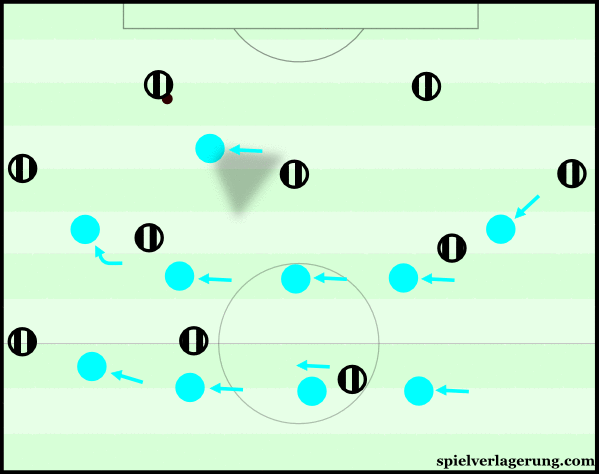
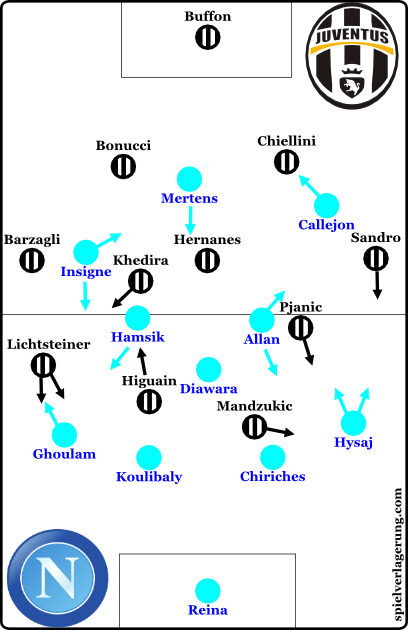
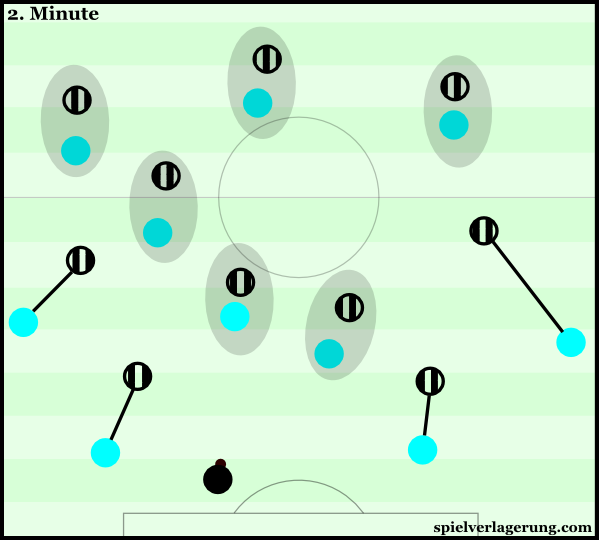
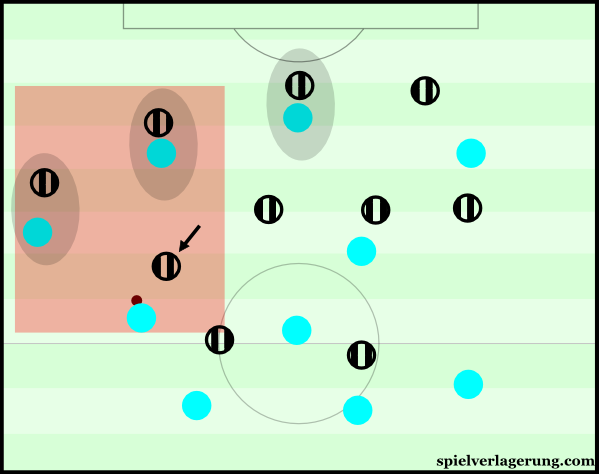
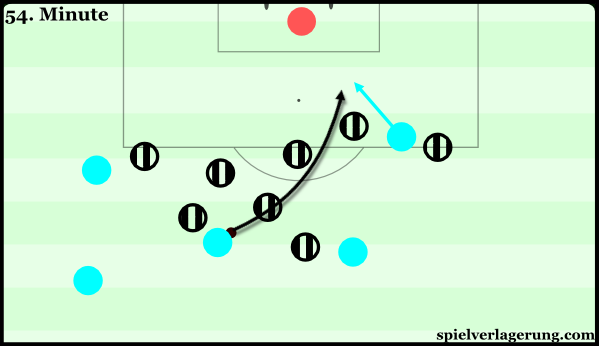
2 Kommentare Alle anzeigen
August Bebel November 13, 2016 um 11:39 am
I’m pretty late here, but I wondered if anyone knows why Jorginho was benched?
Great analysis, by the way. Napoli does really love that chip ball from the left to Callejon.
Jon Adam November 2, 2016 um 10:58 pm
Judging from the tactical board, it looks like pjanic was too isolated on juves left (not to mention the press problem w chiellini sandro callejon) to be creative. do you consider that a problem? i would have thought that pjanic was where our creativity should come from (as opposed to marchisio being a sort of water holder/possession renewer). i admit i havent watched him a great deal. am i misunderstanding the nature of his past assist tallies?